Polynomials can be divided using long division of polynomials. Dividing the polynomials in this format allows us to better visualize each of the steps involved. If we get a remainder after doing the division, we must include it in the final answer by writing it as a fraction.
Here, we will look at a summary of the process used to divide polynomials. Also, we will explore several examples with answers of the division of polynomials in order to visualize the application of this process.
Summary of division of polynomials
To divide polynomials that contain more than one term, we have to use the so-called long division of polynomials. We carry out the long division of polynomials by following these steps:
Step 1: We have to make sure that the polynomial is written in descending order. If there are any missing terms, we use a zero to fill a space or we just leave a blank space.
Step 2: We divide the term with the greatest power inside the division symbol by the term with the greatest power outside the division symbol.
Step 3: We multiply or distribute the answer obtained in the previous step by the polynomial in front of the division symbol.
Step 4: We subtract the obtained expression and write the next term.
Step 5: We repeat steps 2, 3, and 4 until there are no more terms remaining.
Step 6: We write the final answer. The remaining term after the last terms have been subtracted is the remainder. We must write the remainder as a fraction in the final answer.
Division of polynomials – Examples with answers
The long division process mentioned above is used to solve the following polynomial division examples. It is recommended that you try to solve the exercises yourself before looking at the solution.
EXAMPLE 1
Solve the division of polynomials: $latex \frac{{{x}^2}+8x+15}{x+5}$.
Solution
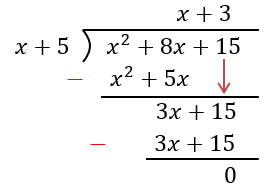
Step 1: The polynomials are already arranged in descending order.
Step 2: We start dividing the $latex {{x}^2}$ by x, which is equal to x.
Step 3: By multiplying this answer by the polynomial in front $latex (x + 5)$, we have $latex {{x}^2}+5x$.
Step 4: We subtract this expression and get $latex 3x$. We place down the 15 to complete the polynomial.
Step 5: When dividing $latex 3x$ by x, we get 3. We multiply 3 by $latex x+5$ to get $latex 3x+15$. When subtracting we get zero.
Step 6: The final answer is $latex x+3$.
EXAMPLE 2
What is the result of this division?: $latex \frac{2{{x}^3}+7{{x}^2}+10x+8}{x+2}$.
Solution
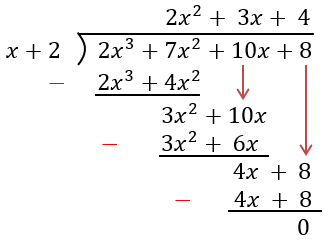
Step 1: Here, the polynomials are also arranged in descending order.
Step 2: We start dividing the $latex 2{{x}^3}$ by x, which is equal to $latex 2{{x}^2}$.
Step 3: We multiply this by the polynomial $latex x+2$, to get $latex 2{{x}^3}+4{{x}^2}$.
Step 4: We subtract this expression to get $latex 3{{x}^2}$. We place down the 10x to complete the polynomial.
Step 5: When dividing $latex 3{{x}^2}$ by x, we get 3x. Multiplying and subtracting, we have $latex 4x$. We place down the 8 to form $latex 4x+8$. By dividing $latex 4x$ by x, we have 4. Multiplying and subtracting, we have 0.
Step 6: The final answer is $latex 2{{x}^2}+3x+4$.
EXAMPLE 3
Solve the division: $latex \frac{{{x}^2}-3x+6}{x+2}$.
Solution
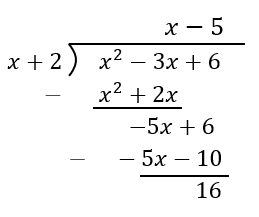
Step 1: The polynomials are already organized.
Step 2: We start by dividing the $latex {{x}^2}$ by x, to get $latex x$.
Step 3: Multiplying by $latex x+2$, we get $latex {{x}^2}+4x$.
Step 4: Subtracting, we get $latex -5x$. We place down the 6 to complete the polynomial.
Step 5: By dividing $latex -5x$ by x, we have -5. Multiplying and subtracting, we have 16.
Step 6: The final answer is $latex x-5+\frac{16}{x+2}$.
EXAMPLE 4
What is the result of the division?: $latex \frac{{{x}^5}+{{x}^2}+{{x}^4}+{{x}^3}+x+1}{x-1}$.
Solution
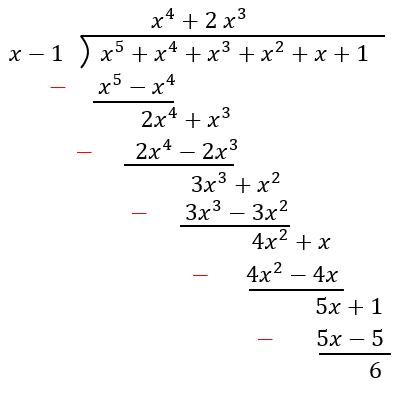
Step 1: We start by organizing the polynomials in descending order.
Step 2: We divide the $latex {{x}^5}$ by x, to get $latex {{x}^4}$.
Step 3: Multiplying this by $latex x-1$, we get $latex {{x}^5}-{{x}^4}$.
Step 4: Subtracting this expression, we have $latex 2{{x}^4}$. We place down to the $latex{{x}^3}$ to complete the polynomial.
Step 5: We repeat steps 2, 3, and 4 until completing the division and obtaining the 6 as the remainder.
Step 6: The final answer is $latex {{x}^4}+2{{x}^3}+\frac{6}{x-1}$.
EXAMPLE 5
Solve the division $latex \frac{{{x}^8}+{{x}^7}+{{x}^4}+{{x}^5}+{{x}^6}+{{x}^3}+{{x}^2}+x}{x+1}$.
Solution
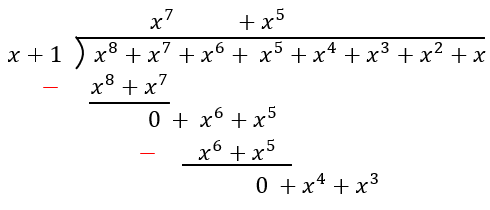
Step 1: We have to order the polynomials in descending order and leave space if there are not all the terms.
Step 2: We start by dividing the $latex {{x}^8}$ by x, to get $latex {{x}^7}$.
Step 3: We multiply this by the polynomial $latex x+1$, to get $latex {{x}^8}+{{x}^7}$.
Step 4: We subtract this expression to get 0. We place down the next terms to divide.
Step 5: By dividing $latex {{x}^6}$ by x, we get $latex {{x}^5}$. Multiplying and subtracting, we have 0.
Step 6: We can observe a pattern in the division. The terms always cancel leaving a remainder of 0. Since we have an even number of terms in the divisor, the remainder will be 0 and the quotient will be $latex {{x}^7}+{{x}^5}+{{x}^3}+x$.
→ Polynomial Division Calculator
Division of polynomials – Practice problems
Practice dividing polynomials using the following problems. Solve the exercises and select the answer obtained. Click “Check” to verify that you got the correct answer.
See also
Interested in learning more about operations with polynomials? Take a look at these pages:




